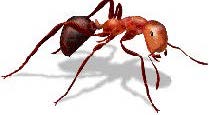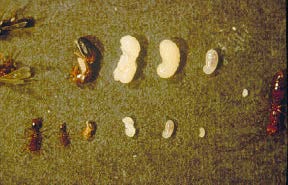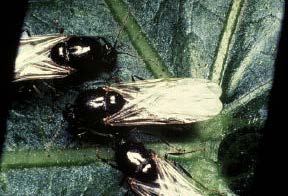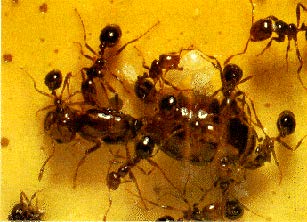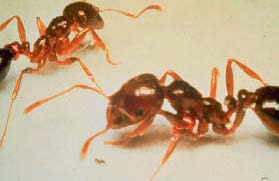Red Imported Fire Ant Biology
The Biology of Red Imported Fire Ants
Red Imported Fire Ants continue to move farther North in the United States. Their
presence affects agriculture, land development, businesses, and recreation. In
order to better deal with the increasing problems that Red Imported Fire Ants cause
it is important to understand the ants themselves. Enclosed in this brochure you will
find information about their life cycles, reproduction, mound development, and foraging.
It is hoped that with this basic information you will be better prepared to deal with
the Red Imported Fire Ants you encounter.
Red imported fire ants live in colonies that contain cream-colored to white immature ants, often called brood. The brood is comprised of the eggs, larvae, and pupae. Also within the colonies are adult ants of different types, or castes. The castes include winged males, winged females (which are unmated queens), workers of varying size, and one or more mated queens.
The winged males and females fly from nests, usually in the spring and early summer, to mate in flight. Upon landing, mated females will shed their wings after finding a suitable nesting site. All the males die after mating. While thousands of winged males and females can be produced per year in large colonies, they do not sting, and fewer than 10% of the females will survive to produce a colony. Newly-mated queens can fly as far as 12 miles from the nest (or even farther in the wind), but most land within a mile.
New colonies do not make conspicuous mounds for several months. Once a colony is established, a single queen can lay over 2,000 eggs per day. Depending on temperature, it can take 20 to 45 days for an egg to develop into an adult worker. Workers can live as long as 9 months at 75°F, but life spans usually are between 1 and 6 months under warmer outdoor conditions. Queens live an average of 6 to 7 years.
Fire ants are omnivorous feeders, feeding on carbohydrates (e.g. honeydew, plant exudates,
sugars, syrups), proteins (e.g. insects, meats), and lipids (e.g. grease, lard, oils
from seeds). Their food preferences change depending on the nutritional
requirements of the colony. In the spring and summer, when food is abundant, the colony
produces new offspring, and the protein needs of the colony
increase. Adult ants require carbohydrates and/or lipids to sustain themselves throughout
the year. Fire ants are only able to ingest liquids. Solid proteinaceous foods are
liquefied by placing them on a depression in front of the mouth of the oldest
larvae (the fourth instar stage), which then regurgitate digestive enzymes onto the
food. Once liquefied, the fourth instar larvae suck up the protein and regurgitate
it to the workers, which pass it on to the rest of the colony.
Workers will forage for food more than 100 feet from the nest. They can forage during both the day and the night, generally when air temperatures are between 70° and 90°F. When a large food source is found, fire ants recruit other workers to help take the food back to the colony. Liquids are ingested at the food source, and stored within the ants until they are regurgitated to other ants within the colony. Liquids from solid foods are extracted at the source, or are carried back as solid particles. Large solids may be cut into smaller pieces so they can be carried back to the colony.
There are two types of fire ant colonies:
- single-queen, or monogyne, colonies, and
- multiple-queen, or polygyne, colonies
Single-queen colonies have only one egg-laying queen, and may contain as many as 100,000 to 240,000 workers. Multiple-queen colonies have many egg-laying queens (usually 20 to 60), with 100,000 to 500,000 workers. Single-queen colonies fight with other fire ant colonies. Because of this antagonistic behavior, colonies are farther apart, resulting in a maximum of 40 to 150 mounds per acre. Multiple-queen colonies generally do not fight with other multiple-queen colonies. Consequently, mounds are closer together, and can reach densities of 200 to 800 mounds per acre. Multiple-queen mounds may also be inconspicuous, often times being clusters of small, flattened excavations, in contrast to the distinct dome-shaped mounds of single-queen colonies. Workers from single-queen colonies vary in size, ranging in length from 1/8 to 1/4 in, and are usually reddish brown to black in color. Workers of multiple-queen colonies are generally smaller (1/8 to 3/16 in), have only a few large workers, and are lighter in color (orangish- brown) than single-queen colony workers.
The large colony sizes, and the presence of numerous queens makes multiple-queen colonies more difficult to eliminate than single-queen colonies. Since 1973, multiple-queen colonies have been found in eight of the 11 fire ant infested states. Multiple-queen colonies produce fewer winged, or alate, queens that will start new colonies after a mating flight than single-queen colonies. However, multiple-queen colonies can establish new colonies by budding, where a portion of the queens and workers splits off from a colony.
The spread of fire ants into new areas depends on many factors, such as climate, surrounding
fire ant populations, and the native predators and competitors
in the areas. Areas with an abundance of natural enemies and competing ant species
may hinder colony establishment because the enemies prey upon newly-mated queens and
compete for resources. However, if an area is disturbed, for example, by clearing
land for pastures or urban development, natural enemies or competitors may be adversely
affected and fire ants may colonize the area more rapidly.
It may take as long as 11 years for single-queen fire ant colonies to become the dominant ant species in a new area which has been disturbed by urbanization, and has not been treated with insecticides to control ants. Multiple-queen colonies may become dominant in new areas at a slower rate because they spread more by budding than by establishing numerous new colonies scattered throughout an area after mating flights.
In areas where native ants and fire ant populations have been reduced or eliminated with insecticides, reinfestation by fire ants may be noticeable within a month after treatment. Fire ants reinfest these areas more rapidly and outcompete other ant species because of their tremendous reproductive capacity and faster colony development. If fire ant control is not maintained, the subsequent reinfestation of an area may result in even greater fire ant populations than existed before the application of insecticides.
Oklahoma State University and the Oklahoma Cooperative Extension Service is dedicated to Integrated Pest Management research and training. If you have any further questions please contact:
Wayne A. Smith
P.O. Box 749
Durant, OK 74702
(580) 924-5312
Dr. J. T. Vogt
Fire Ant Specialist
North American Fire Ants
Solenopsis geminata: tropical fire ant, inhabits
coastal areas.
Solenopsis xyloni: southern fire ant, inhabits
Southeast United States.
Solenopsis richteri: black fire ant, inhabits Northern
Mississippi and Alabama.
Solenopsis saevissima richteri: hybrid cross of black
and red imported fire ant, inhabits Mississippi and
Alabama.
Solenopsis invicta: red imported fire ant, inhabits
Southern U. S., movement continues to spread.
The Red Imported Fire Ant biological information contained in this brochure was borrowed from the University of Florida and Florida Cooperative Extension Service Fact Sheet ENY-226. The pictures displayed herein were borrowed from the Imported Fire Ant Bytes CDROM, produced by the University of Arkansas College of Engineering and University of Arkansas Cooperative Extension Service. The information given herein is for educational purposes only Oklahoma Cooperative Extension Service offers its programs to all eligible persons regardless of race, color, national origin, religion, sex, age or disability and is an equal opportunity employer.

